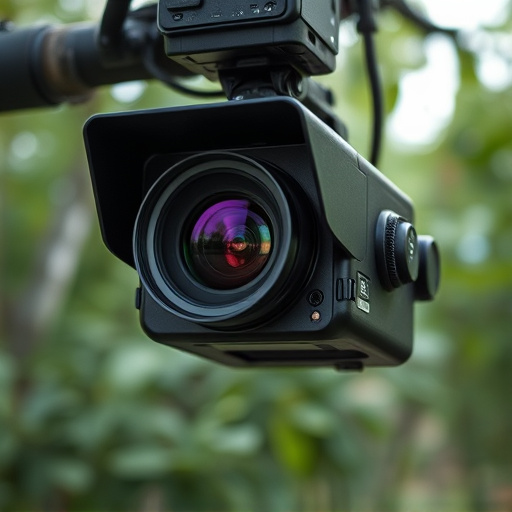Wireless spy cameras, operating via radio frequency (RF) signals, offer remote access but pose privacy risks. Detecting these cameras requires understanding RF interference from everyday devices. Advanced tools and mobile apps scan RF frequencies for live feeds, enhancing privacy. Legal frameworks regulate unauthorized use, with severe consequences. Protect yourself through tech precautions and physical security measures to prevent wireless spy camera live phone viewing.
“Uncover the unseen with our comprehensive guide on detecting hidden cameras using radio frequency (RF) technology. In an era where privacy is paramount, understanding wireless spy cameras and their operation is crucial. This article equips you to identify these clandestine devices through recognizing RF interference sources and exploring advanced detection tools. Learn legal rights and preventive measures to secure your spaces from invasive surveillance, including live phone viewing of hidden cameras. Stay informed, stay protected.”
- Understanding Wireless Spy Cameras and Their Operation
- Identifying Potential Sources of Radio Frequency Interference
- Tools and Technologies for Detecting Hidden Cameras
- Legal Considerations and Privacy Concerns
- Preventive Measures: Securing Against Spy Cameras in Your Space
Understanding Wireless Spy Cameras and Their Operation
Wireless spy cameras, often referred to as hidden cameras, have evolved significantly in recent years, with many operating wirelessly and transmitting video feeds via radio frequency (RF) signals. These devices can be incredibly subtle, making them a popular choice for surveillance purposes. They are typically designed to capture video footage discreetly, allowing users to remotely access live streams through their smartphones or computers.
The operation of wireless spy cameras involves several components: the camera itself, a transmitter, and a receiving device. The camera captures the video, which is then transmitted wirelessly over an RF signal. This signal can be received by a compatible smartphone app or computer software, enabling real-time viewing. Understanding these systems is crucial when aiming to detect and identify hidden cameras, especially in scenarios where live phone viewing of surveillance feeds may be necessary for security professionals or privacy-conscious individuals.
Identifying Potential Sources of Radio Frequency Interference
When it comes to detecting hidden cameras, understanding radio frequency (RF) interference is key. Wireless spy cameras often transmit video and audio data via RF signals, making them susceptible to detection through interference with nearby devices. Common sources of RF interference include wireless routers, Bluetooth devices, baby monitors, and even microwave ovens. While these everyday items may not be the hidden camera itself, they can mask or disrupt the signal from a live phone viewing device, making it more challenging to identify clandestine surveillance equipment.
Identifying potential sources of RF interference is an important step in your search for hidden cameras. By mapping out and understanding the RF environment, you can better isolate suspicious signals and narrow down potential locations of wireless spy cameras. This proactive approach enhances your chances of successfully detecting and disabling these types of covert listening devices.
Tools and Technologies for Detecting Hidden Cameras
Detecting hidden cameras has evolved with advancements in technology, offering a range of tools and solutions to safeguard privacy. One effective method is utilizing wireless spy camera detection devices that can identify live streaming feeds from hidden cameras. These gadgets are designed to scan radio frequencies (RF) and detect signals emitted by covert surveillance equipment. By tuning into specific bands, users can uncover hidden cameras in homes, offices, or public spaces.
Additionally, mobile apps have entered the market, providing a convenient way to monitor for wireless spy cameras. With real-time phone viewing capabilities, individuals can check their surroundings and ensure security. These applications often employ advanced algorithms and RF signal analysis to detect potential hidden camera feeds, offering users peace of mind in today’s digital age where privacy is paramount.
Legal Considerations and Privacy Concerns
In many regions, the deployment and use of hidden cameras, especially those operating via radio frequency (RF) signals like wireless spy cameras, are subject to strict legal frameworks designed to protect individual privacy. It’s crucial for users to understand these laws, as unauthorized surveillance through live phone viewing of such devices can result in severe penalties. The legality of using RF-enabled hidden cameras varies by jurisdiction, with some countries having more stringent regulations than others.
Privacy concerns surrounding wireless spy cameras and similar devices are multifaceted. They not only invade personal privacy but also raise ethical questions about the right to consent and the potential misuse of surveillance footage. Even in situations where such cameras might be used for security purposes, their unauthorized deployment can lead to severe repercussions, including civil lawsuits, as individuals have the right to expect privacy in their living spaces and digital communications.
Preventive Measures: Securing Against Spy Cameras in Your Space
Preventing unauthorized surveillance is crucial in today’s digital era, especially with the rise of wireless spy cameras capable of live phone viewing. To secure your space against such intrusions, start by conducting regular checks for any suspicious devices or unusual signals. Look for hidden camera components like lenses, connectors, or signal emitters that might be disguised as everyday objects. Regularly updating security software and avoiding connecting unknown devices to your network can also help mitigate risks.
Consider enhancing physical security measures such as using secure locks on doors and windows, installing surveillance systems independently of Wi-Fi networks, and being vigilant about unfamiliar individuals accessing your premises. By combining technological precautions with robust physical security, you can create a safer environment, ensuring that your personal and private moments remain just that—private.
Understanding the operation of wireless spy cameras, identifying potential sources of interference, utilizing specialized tools and technologies, being aware of legal considerations, and taking preventive measures are key steps in securing your personal space from hidden camera threats. By staying informed and proactive, you can protect your privacy and ensure a safer digital environment. Remember that awareness is the first line of defense against these modern-day surveillance devices, such as Wireless Spy Cameras, and their Live Phone Viewing capabilities.
